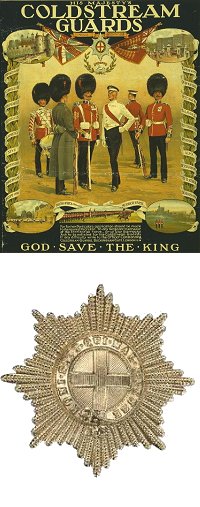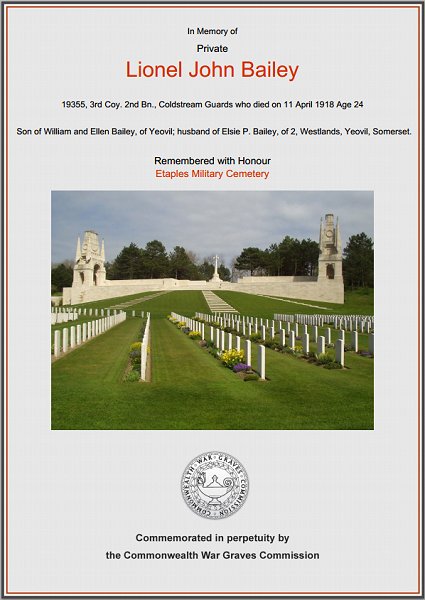yeovil at War
John Lionel Bailey
Died at Arras, in the German Spring Offensive of 1918
John Lionel Bailey was born in Yeovil in 1894. He was the son of Cheese Dealer William Bailey (b 1847) and his wife Ellen (b 1857). On the night of the 1901 census William was listed at 1 Greyhound Yard, off South Street behind the Greyhound Inn, with son William, while Ellen, with two sons John and Alfred, were visiting in Twerton, Bath, Somerset. In the 1911 census William and Ellen were listed at South Street with their four children; 17-year old John, 12-year old Alfred, 7-year old Iris and 4-year old Stanley. John gave his occupation as Cheese Dealer and clearly worked with his father.
In the summer of 1814 John married Elsie P Raymond at Yeovil and they set up home at 2 Westlands (today's Westland Road).
 John
enlisted in the
army at Taunton
in October 1916
although he was
recorded as
Lionel John
Bailey instead
of John Lionel.
In any event he
became Private
Bailey
(Service No
19355) of 3rd
Company, 2nd
Battalion,
Coldstream
Guards.
John
enlisted in the
army at Taunton
in October 1916
although he was
recorded as
Lionel John
Bailey instead
of John Lionel.
In any event he
became Private
Bailey
(Service No
19355) of 3rd
Company, 2nd
Battalion,
Coldstream
Guards.
In the summer of 1915 the Guards Division was formed and the 2nd Battalion, Coldstream Guards moved to 1st Guards Brigade. In July 1916 the Division left the Salient to take part in the great Allied offensive of the Somme. It was at this time that John Bailey joined his regiment at the front.
On the 15th September all three Coldstream Battalions were in the front line of assault, the first and only time the Regiment has gone into action as a whole. The losses in the three Coldstream Battalions amounted to 40 Officers and 1326 other ranks.
The winter of 1916-17 was spent in trench warfare on the Somme and in the summer and autumn of 1917 the Regiment played a prominent part in the Battle of Passchendaele.
In November 1917 the Guards Division moved south from Flanders in readiness for the next Allied offensive. During the Battle of Cambrai the 2nd Battalion took part in the confused fighting around Gouzeaucourt which defeated a major German counter attack. The great German offensive of March 1918 saw the Guards Division now engaged in the area south-west of Arras. John Bailey was wounded during this prolonged battle (around the time another Yeovil lad in his Battalion, Edwin Aldworth, was killed). John was evacuated to one of the several military hospitals around Etaples, and on 11 April 1918 he died from his wounds. He was aged just 24.
John Lionel Bailey was interred in Etaples Military Cemetery, Grave XXXIII.G.14A. His name (as Lionel John) is inscribed in the County of Somerset Book of Remembrance in St Martin's Chapel, Wells Cathedral, page 174, and his name is also inscribed on the War Memorial in the Borough.
gallery

The Memorial Plaque commemorating Lionel Bailey. Also known as Death Plaques, the plaques were made of bronze, and hence popularly known as the "Dead Man’s Penny", because of the similarity in appearance to the somewhat smaller penny coin. Diameter approx. 120mm, rim thickness approx. 4mm, weight approx. 333g. 1,355,000 plaques were issued, which used a total of 450 tons of bronze. They continued to be issued into the 1930s to commemorate people who died as a consequence of the war.

The Commonwealth War Graves Commission certificate in memory of John Bailey.